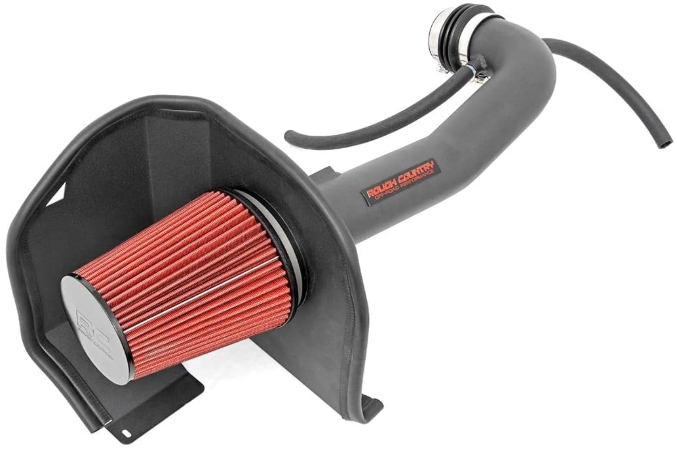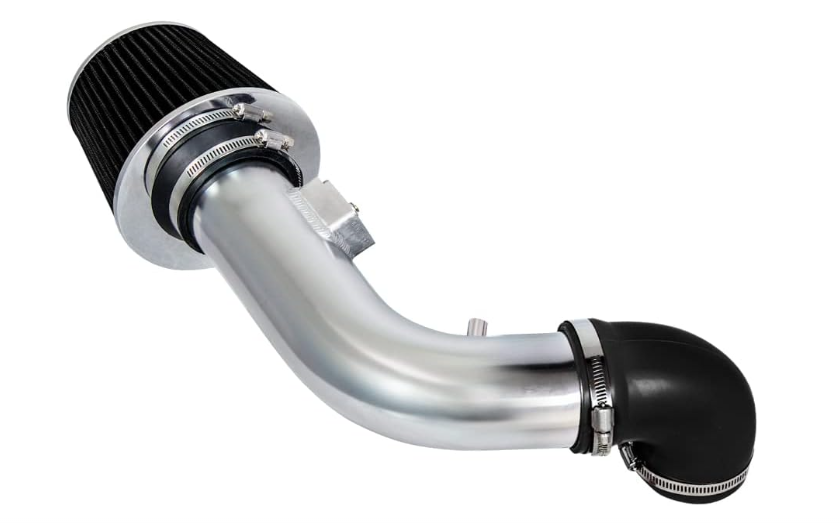We may earn commission from links on this page at no extra cost to you. We only recommend products we back!
Cold Air Intake vs Short Ram Intake: Cold air intakes improve performance by drawing cooler air, while short ram intakes offer quicker throttle response but may draw in warmer air, affecting performance.
When it comes to upgrading vehicle’s intake system, two popular choices come up: the cold air intake vs short ram intake. Both offer different advantages depending on what you are looking for in terms of performance, sound, installation complexity, and cost.
In this article, we’ll compare these two intake systems in-depth, analyze the pros and cons, and help you decide which one is better suited to your driving needs.
What is a Cold Air Intake (CAI)?
A cold air intake system is designed to take air from outside the engine bay, where the air is cooler and denser. This is beneficial because denser air contains more oxygen, which can improve combustion efficiency, ultimately increasing horsepower and torque. The system typically includes a longer intake tube, a high-flow air filter, and a positioning that draws in cool air from the front of the vehicle or under the car.

How Does a Cold Air Intake Work?
The principle behind the cold air intake system is simple: cooler air is denser, and when an engine inhales cooler, denser air, it can burn more fuel, leading to more power. These systems typically have longer tubing that reaches into the cooler areas of the engine bay or outside the vehicle to avoid the hot air that accumulates in the engine compartment.
Benefits of a Cold Air Intake
A cold air intake is one of the most popular aftermarket upgrades for cars, and for good reason. Here’s a breakdown of the benefits of a cold air intake, especially for performance and efficiency enthusiasts:
- Performance Gains: The primary advantage of the cold air intake is its ability to boost engine performance by improving airflow. The cooler, denser air increases the oxygen available for combustion, which leads to more horsepower and torque.
- Improved Throttle Response: As the engine breathes cooler air, throttle response improves, making the car feel more responsive.
- Fuel Efficiency: In some cases, the cooler air results in a more efficient combustion process, improving fuel economy.
- High-End Power: If you are looking to boost top-end horsepower, particularly for highway or track use, the cold air intake is a preferred choice.
What is a Short Ram Intake (SRI)?
In contrast, a short ram intake system is designed to be shorter and draw air from within the engine bay. While this air is generally warmer than the outside air, the system provides quicker airflow to the engine. Short ram intakes are usually easier to install, less expensive, and offer gains in throttle response at lower speeds.

How Does a Short Ram Intake Work?
Unlike a cold air intake, the short ram intake system uses a much shorter intake tube, typically no longer than a few feet. The air it draws in is generally from within the engine bay, meaning it is warmer than the cooler air outside. While this might reduce the amount of oxygen in the air, the shorter intake tube means less resistance, improving throttle response.
Benefits of a Short Ram Intake
A short ram intake is another popular aftermarket intake system, and while it’s different from a cold air intake, it has its own set of advantages. Here are the key benefits of a short ram intake:
- Faster Throttle Response: A short ram intake is designed to provide a snappier throttle response by reducing the distance the air has to travel to reach the engine. This can lead to faster acceleration, especially in low- to mid-range RPMs.
- Ease of Installation: The short ram intake is much easier to install than a cold air intake, making it ideal for beginners or those who want a quick, hassle-free modification.
- Cost-Effective: Short ram intakes tend to be more affordable than cold air intakes, making them a popular choice for those on a budget.
- Better for Urban Driving: If your driving mainly involves city traffic, the short ram intake provides a better throttle response for stop-and-go driving, which makes it a great option for daily commuters.
Cold Air Intake vs Short Ram Intake: Key Differences
Here’s a concise breakdown of the key differences between Cold Air Intakes and Short Ram Intakes across all major categories:
1. Air Temperature and Performance
One of the most significant differences between cold air intake vs short ram intake is the temperature of the air that each draws into the engine.
Cold Air Intake: As the name suggests, the cold air intake system draws cooler air from outside the engine compartment. The cooler air is denser, meaning more oxygen is available for combustion, which can significantly improve engine performance.
Short Ram Intake: The short ram intake, on the other hand, pulls air from within the engine bay, where the air temperature is typically warmer. Warmer air is less dense, which means the engine will receive less oxygen, leading to a decrease in potential performance gains.
2. Installation Complexity
When it comes to installation complexity, cold air intakes and short ram intakes differ quite a bit due to their design and location in the engine bay. Here’s a clear breakdown of the key differences in installation:
Cold Air Intake: Installing a cold air intake is generally more complex. The longer intake tube requires precise installation, and in some cases, the system might need to be routed through the fender or under the car. This could involve removing other components or modifying existing parts, which makes installation more involved.
Short Ram Intake: A short ram intake is significantly easier to install. Since the intake tube is shorter and typically mounted in the engine bay, installation is quicker and doesn’t require as many modifications.
3. Sound
The sound difference between cold air intake vs short ram intake sound is one of the most noticeable factors when you install either system.
Short Ram Intake Sound: A short ram intake, on the other hand, tends to generate a louder, more immediate sound. The intake noise is often more pronounced under lower to mid-range RPMs. If you’re looking for a sharper, more aggressive intake note with a noticeable growl under acceleration, the short ram intake will give you that performance sound.
Cold Air Intake Sound: A cold air intake generally produces a more refined, deep growl as the engine sucks in cooler, denser air. This sound is typically more pronounced at higher RPMs when the engine is demanding more air. If you enjoy a throaty roar and a more aggressive tone when you accelerate, the cold air intake is the way to go.
Cold Air Intake vs Short Ram Intake: Final Thoughts
Now that we’ve broken down the key differences and benefits of both systems, let’s discuss how to make the right choice based on your goals and driving style.
What’s Better: Cold Air Intake or Short Ram Intake?
Ultimately, the decision between cold air intake vs short ram intake boils down to your specific needs, preferences, and driving conditions. Here are a few guiding factors to help you decide:
You’re looking for an entry-level modification that’s easy to install and maintain.
Choose Cold Air Intake if:
- You’re looking for maximum performance, especially at high speeds.
- You want to optimize the vehicle for long highway drives or track days.
- You don’t mind spending more for a complex installation and the potential risk of water ingestion.
- You’re upgrading a turbocharged vehicle and need cooler, denser air for optimal combustion.
Choose Short Ram Intake if:
- You need better throttle response for city driving or daily commuting.
- You’re on a budget and prefer an easier, more affordable modification.
- You want a louder intake sound and quicker acceleration, especially in lower RPM ranges.
Short Ram Intake vs Cold Air Intake: Which One Is Better for Turbocharged Vehicle?
When it comes to turbocharged vehicles, you may wonder if cold air intake or short ram for turbo vehicles make a significant difference. Generally, a cold air intake is more beneficial for turbocharged vehicles. Turbo engines thrive on cooler air to increase performance, and the denser, cooler air provided by a cold air intake system will help maximize the power output of the turbocharged engine.
However, some drivers might prefer the short ram intake vs cold air intake sound difference in turbo setups, as the shorter intake gives a more aggressive intake noise, which can enhance the driving experience, especially in cars where the turbo whine is a focal point of the performance sound.
Maintenance Tips for Cold Air and Short Ram Intakes
Proper maintenance is key to ensuring that the intake system performs optimally for years to come.
Cold Air Intake Maintenance
Keeping the cold air intake system in top shape is essential not only for optimal performance but also to prolong the life of the engine. Over time, dirt, debris, and moisture can accumulate in the system, reducing airflow and potentially damaging components if not addressed.
- Clean or Replace Filters: The air filters in cold air intakes are designed to be reusable. You’ll need to clean them regularly to ensure they don’t become clogged with dirt and debris. Typically, cleaning cold air intake should be done every 15,000-20,000 miles, but it depends on your driving conditions.
- Inspect for Water Ingestion: One of the biggest risks with cold air intakes is water ingestion, particularly if the intake is positioned low to the ground. Always inspect the intake for signs of water or debris and ensure that the filter is in good condition. Read more about Cold Air Intake Water Protection Systems.
Short Ram Intake Maintenance
Just like a cold air intake, a short ram intake requires regular maintenance to keep the engine breathing clean, unrestricted air. Since are located in the engine bay and are more exposed to heat and debris, staying on top of upkeep is critical for performance and longevity.
- Regular Cleaning: Like cold air intakes, short ram intakes require periodic cleaning. The filters should be cleaned every 10,000-15,000 miles to maintain airflow efficiency.
- Check for Air Leaks: Since short ram intakes are typically mounted in the engine bay, make sure the intake tube and connections are tightly sealed to prevent air leaks, which could reduce performance.
Conclusion
The cold air intake vs short ram intake debate is a longstanding one, and the best choice depends on own priorities. If you want maximum performance and improved horsepower, particularly for high-speed or track use, the cold air intake is likely the better option. If you prefer faster throttle response, easier installation, and a more affordable option, the short ram intake could be the better choice for you.
Both intake systems have their advantages, and either one can provide noticeable improvements to the vehicle’s performance. By understanding the difference between short ram intake and cold air intake, as well as considering factors like installation, cost, sound, and performance, you can make an informed decision that aligns with your goals and driving style.
So, whether you choose a cold air intake or short ram for turbo, or simply want to enhance the sound of the vehicle, both systems can help take the driving experience to the next level. Choose wisely based on the vehicle’s needs and your personal preferences, and enjoy the improvements these intake systems bring!
Amazon and the Amazon logo are trademarks of Amazon.com, Inc, or its affiliates.
Leave a Reply